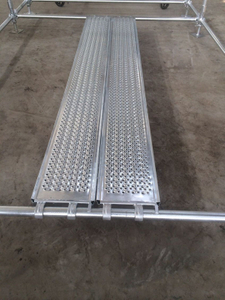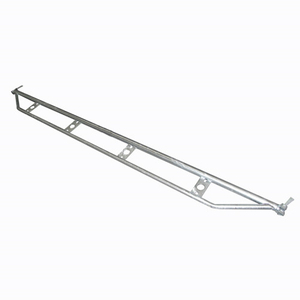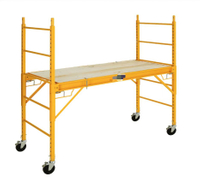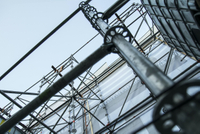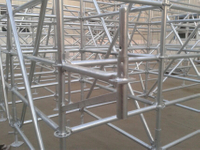The construction of scaffolding is one of the most critical aspects of the building and is used to support the builder and its materials during the construction process. So, the ringlock scaffolding is one of the most popular scaffolding. What kind of material does it use?
Basic ringlock scaffolding element
What is the material for making the ringlock scaffolding?
What is the application of the ringlock scaffolding?
Conclusion
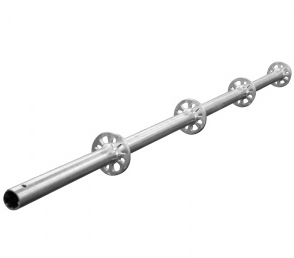
Basic ringlock scaffolding element
The ringlock scaffolding is used to provide external structural support for people in construction and construction work. In addition to couplers and plates, materials such as metal pipes or pipes are often used as the backbone of the ring lock scaffolding. However, regardless of the material, the ring lock scaffolding must comply with European performance requirements and structural design method standards.
Because scaffolding must be compatible with a variety of buildings and structures, there are a variety of scaffolding to meet specific building requirements. However, all scaffoldings are made up of the same basic elements, although the way they are designed and the way these elements are combined can vary.
The basic scaffolding elements include three common components: standard, ledger and beam. A standard is that the mass of the bracket is directly connected to the long tube or tube of the ground and the length of the scaffold it operates. Each standard base is attached to the base plate, which helps to distribute the weight of each standard bear. Between each standard operating horizontally is a ledger that adds further support and weight distribution. Beams placed at the top of the ledger at right angles come in several different forms. The main beam supports the standard by attaching the standard to the support and support plates. The intermediate beam is placed with the main beam to provide additional plate support.
In addition to standards, ledgers and beams, there are other supporting elements that can be used to enhance basic scaffolding. Parentheses, such as ribs, ivory braces, and additional couplers, can be used in different combinations to support multiple ways of structure. The cross brackets run diagonally between the ledgers and are securely attached to the standard to increase the overall rigidity of the structure. However, it can also fix itself on the ledger, in which case they are simply referred to as ledgers. The outer wall support helps prevent structural rocking and adheres to the surface of the scaffolding, extending along the surface of the structure and firmly attached to each level.
Couplers help to connect structural elements and have a variety of variants. To connect the ledger or beam to the standard, a right angle coupler should be used. If the beam supports the board and must be connected to the ledger, the ledger should be connected to the beam using a putlog or single coupler. Rotating joints are recommended for any other connection angle between the scaffolding pipes.
The length, width and height of each scaffolding component can vary from building to building, but there are several basic measurements for each basic component. The general width of the stent is typically determined by the width of the stent panel. The height between the ledgers, also known as the lift height, is usually between 2 and 2.7 meters. Beam placement depends on board thickness. If the board has a thickness of 38 mm, the beams should be at most 1.2 m apart. A 50 mm thick board requires beams to be no more than 2.6 meters apart.
In addition to the basic structural elements of the scaffolding, there are a variety of ties that secure the scaffolding to adjacent buildings. As a general rule, connect every 4 meters at alternate lift levels. However, the type of lacing and the type of lacing used may vary depending on the type of stent. For example, by connecting, the scaffolding can be secured to the building by entering an open window of the building. The box ties help to secure the scaffolding by connecting to external features of the building, such as strong columns.
hook up. The hook plates are placed horizontally and adjacent to each other. They hang on the ledger, thus creating a surface area where people can stand.
Base jack. These are important because they allow the scaffolding to be flattened. Sturdy scaffolding requires multiple bases to be as strong as possible.
Enter the ladder. The purpose of accessing the ladder is the name. It allows the person using the scaffold to reach the hook board all the time.
Trapdoors. The trapdoor also has a fairly textual name. It is a whole in the hook area where workers can climb over. This helps them use the channel ladder to move the scaffold up or down.
Scaffolding labels. The scaffolding label is ideal for communication between workers. They are markers that indicate whether an area is safe with respect to scaffolding.
What is the material for making the ringlock scaffolding?
Scaffolding materials include:
Tube, color, plate or decorative board
The tube is usually made of steel or aluminum. The steel grade used is usually hot rolled steel. In the special case of the risk of overhead cables, a fiberglass wound tube in a nylon or polyester matrix can be used.
The main difference between steel and aluminum is weight: steel is nearly three times heavier than aluminum.
The metal tubes are held together by a coupler. There are three basic types: right angle couplers, putlog couplers and rotary couplers. In addition, the joint pins (sleeve) or sleeve joints can be used to connect the tubes end-to-end if necessary.
The floor of the scaffolding structure can be made of wood or a decorative board made of steel or aluminum. Where wood boards are used, their ends are protected by a metal plate called a hoop or nail plate.
What is the application of the ringlock scaffolding?
Use ringlock scaffolding during construction, maintenance and repair. The ring lock scaffold allows workers to enter the high and remote locations of any building.
Scaffolding can take many forms depending on the project at hand.
Support scaffolding is the most common type of scaffolding. It was built from the ground up and is common on most construction sites. This is the easiest, most convenient, safest and most cost-effective scaffolding structure. Additional support can be added if the structure is very high or if a very heavy load needs to be transported.
Suspended scaffolding is usually suspended from the roof of a building. It is not practical to be able to build a base, or to limit access requirements to the upper level and build scaffolding from scratch, which is a good choice.
Rolling scaffolding is structurally similar to supporting scaffolding. The difference is that instead of using a stable base, casters are used to achieve mobility. This provides a good choice if you need to work on the entire length of the building. As long as there are workers or materials on the scaffolding, the wheels must be locked to ensure the safety of everyone nearby.
Conclusion
You must be aware of the importance of using the right materials, which is not an extra cost, but rather makes the process of building and using the ringlock scaffolding as safe as possible. If you are looking for a well-selected, durable high quality ringlock scaffolding,Nanjing Tuopeng Construction Technology can provide you with the perfect product.












